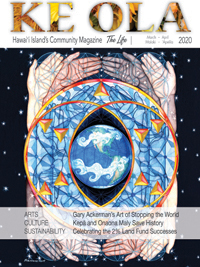Managing with Aloha: Align—Put Your Values to Work
Series 3 on Managing with Aloha, Bringing Hawai‘i’s Universal Values to the Art of Business. Fourth in Series Three on Managing with Aloha
By Rosa Say
To align is to work with integrity by working true to your values, for your values will drive your best, and most desirable, behaviors.
Value alignment is the modus operandi of Managing with Aloha—it’s the constant habit which creates the focus, rhythm, and flow of our work.
The core values a business will choose to guide it, are the activators we want to remain engaged with. In a well-functioning business, we want to trust in the certainty of those activators.

Therefore, when we “manage with Aloha” we do more than allow behavior-driving to happen by matching the right people (of Aloha Spirit) to the right work (Ho‘ohana): we create work habits which assure our focus on the right values happens intentionally and consistently, in that they drive our systems and processes as well. By “right values” we mean the core values you have chosen for your business in particular.
Whether for a business partnership or specific team, deliberate value-alignment creates a healthy organizational culture for everyone involved: when we want to collaborate and co-create, shared values equip and energize us as our “why” and our “how to.” Matching these values with sound systems and processes gets the work done to make sense.
Simply said, to align is to put your values to work for you in practical, useful, and relevant ways.
Envision a simple chart which is a grid of vertical and horizontal lines. The vertical lines represent the core values of your business, and the horizontal lines represent your operational standards and tenets. Standard entries for those horizontal lines might be: the service we provide; the products we manufacture; our distribution channels; our sales and marketing; our financial acumen and fiscal responsibility; our recruitment, selection, and hiring; etc. In addition to the basics of what you actually do, be sure to list those key distinctions you consider your Best Practices and signatures of quality work.
Value alignment is a “get real” analysis you bring to this grid: it is the consistent practice of looking at where your vertical value lines (belief and conviction) and horizontal operational lines (actual practice) meet and intersect—do they align with each other? Does actual practice, and the daily doing of whatever it is your business does, stem from the conviction and belief stated within your core values? Are each of your core values actually the behavior-drivers you want them to be, or not?
From a customer’s and employee’s perspective, your best analytical question about those intersections will be this one: do you keep your promises?
There should be baseline value-alignment requirements for each and every value articulated within the Value Statement a business upholds as its Ethos.
For example: One of the operational tenets in the ‘Ohana in Business, our business model for Managing with Aloha, is this:
“The ‘acid test’ of the workplace culture is Kākou communication: Everyone involved speaks up, and speaks freely regardless of their title or position. Problem-solving and cross-functionality are programmatically designed into this model for continuous improvement, fresh ideas, and dynamic energy generation.”
In our value alignment practice, we will review every facet of Kākou communication to assure the “speaking up” we want happens as the “Speaking with Aloha” we espouse as our Aloha Intention.
Another of our operational tenets is The Role of the Manager Reconstructed. We want to assure what we talked about last issue is realistically possible, i.e., “Making Ho‘ohana happen for everyone in their circle of influence, IS the manager’s Ho‘ohana in Managing with Aloha.” We want that goal to be actionable per the core values relevant to whatever organization we coach, because it is designed into each manager’s daily work.
Analyze your own grid on a regular basis. Choose your preferred process for doing so, and involve as many of your “employees as business partners” as you can without it being too lengthy or burdensome—cycle them in for fresh perspectives. Take immediate steps to correct work design when your value alignment analysis deems it necessary.
Perhaps the most commonly known value alignment processes are Value of the Month programs. They may be “old school” but they work, and work well. Is it time you dusted yours off, giving it new life in 2020?
To align is to focus well and remain on target. Focus all efforts on the right mission and the right vision with your values, for doing so honors the sense of identity of your business. It also brings compelling pictures of the future within your reach, making them your probable, and most promising legacy, your contribution to mankind. ❖
Value Alignment is Key Concept 3 in the Managing with Aloha philosophy: we explore our core values for the guidance they positively lend to our business models. Next issue, we’ll talk about Key Concept 4: The Role of the Manager Reconstructed.
Contact writer Rosa Say at RosaSay.com or ManagingWithAloha.com


